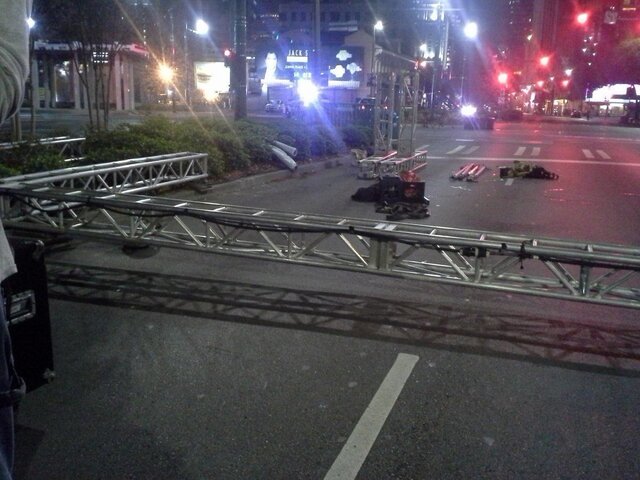You are using an out of date browser. It may not display this or other websites correctly.
You should upgrade or use an alternative browser.
You should upgrade or use an alternative browser.
All trussed up and nowhere to go!
- Thread starterRobert
- Start date
DuckJordan
Touring IATSE Member
Robert
Well-Known Member
Yep, they mounted the top truss sideways. It was already bolted up and that's how they ran with it.
I would like to see some guy wires and some ballast. While no equipment was hung on the truss, it did have two large banners on the span and two more on the vertical legs. I'm thinking wind load and rain as forces not considered.
I would like to see some guy wires and some ballast. While no equipment was hung on the truss, it did have two large banners on the span and two more on the vertical legs. I'm thinking wind load and rain as forces not considered.
DuckJordan
Touring IATSE Member
Robert
Well-Known Member
Wow, even for the horizontal?
DuckJordan
Touring IATSE Member
Attachments
Robert
Well-Known Member
I would love to read up on this. I can't find any sources except one that identifies the top. bottom and sides of a truss for proper orientation.
http://www.tomcatglobal.com/Training/Instructional-Videos/
http://www.tomcatglobal.com/Training/Instructional-Videos/
DuckJordan
Touring IATSE Member
Its not something you will learn online, Tomcat says it in their one on one training when getting a new roof
DuckJordan
Touring IATSE Member
Not with tower truss as pictured here. Its the same vertically as horizontally
Sent from my XT1060 using Tapatalk
Robert
Well-Known Member
So I'm coming back to this after talking to two different truss manufacturers. Consensus being:
You are right, just judging on how the truss is oriented in the photo, it would be on its side when stood up. This would be incorrect, as we want the diagonals to be in the load path.
When questioned further about any truss they manufacture that does not have a top or side he responds:
Well, 12” truss does not have a specific top or bottom. Some companies may flip the truss depending on how loads are being applied to the span, but the diagonals should always be in the load path and the diagonal pattern should be consistent throughout the span.
Point being diagonals should always be in the load path. While this does not exclude a situation where a truss could be mounted sideways, I would consider that very rare.
You are right, just judging on how the truss is oriented in the photo, it would be on its side when stood up. This would be incorrect, as we want the diagonals to be in the load path.
When questioned further about any truss they manufacture that does not have a top or side he responds:
Well, 12” truss does not have a specific top or bottom. Some companies may flip the truss depending on how loads are being applied to the span, but the diagonals should always be in the load path and the diagonal pattern should be consistent throughout the span.
Point being diagonals should always be in the load path. While this does not exclude a situation where a truss could be mounted sideways, I would consider that very rare.
What Rigger?
I'm so fly....I Neverland.
Oh Lorde, please don't let this be the Long Beach GP...I think I get to go this year.
Good opportunity for some more education here.
What are possible rare situations when you would want to have a horizontal truss with the diagonals on the top and bottom?
Robert
Well-Known Member
My rigging is based on lifting lighting, audio, and set pieces in theatrical and corporate/concert type events. My guess would be that there are some instances where a side load is applied to a structure and you would want to rotate the truss to support that. My feeling is this would be more likely to happen where wind loads could react to static loads attached to a structure.
Last edited:
Similar threads
- Replies
- 1
- Views
- 208
- Replies
- 13
- Views
- 2K
- Replies
- 0
- Views
- 984
Users who are viewing this thread
Total: 1 (members: 0, guests: 1)




